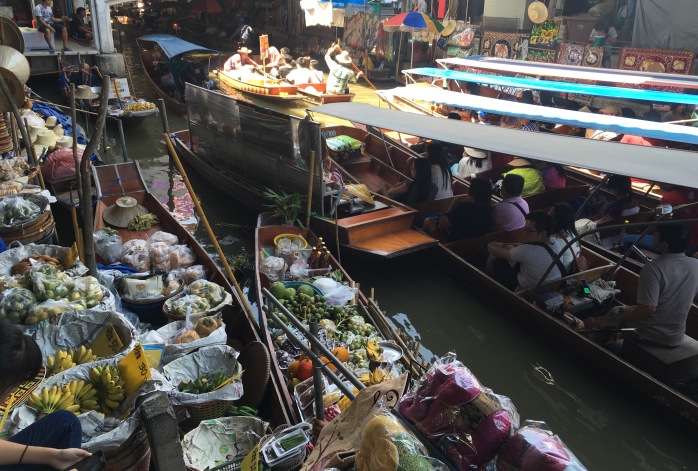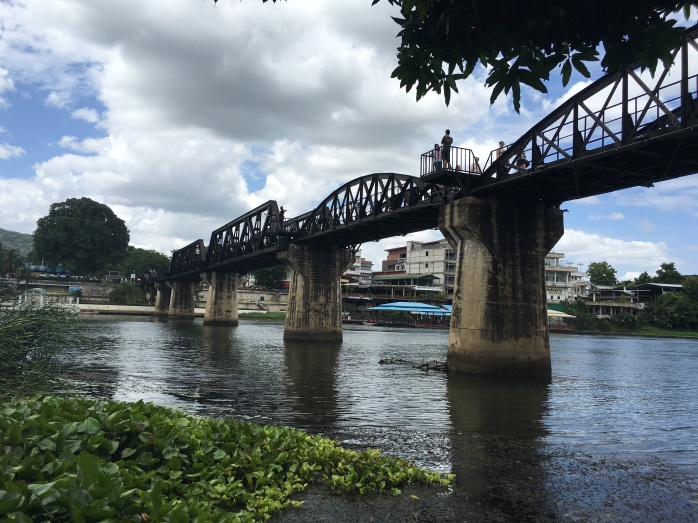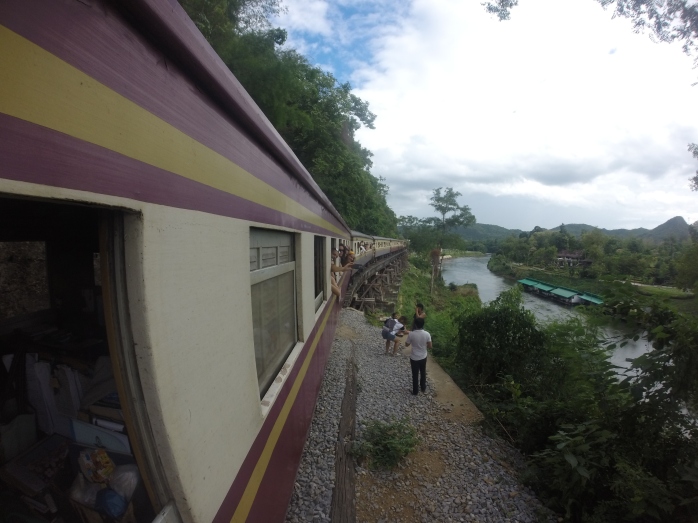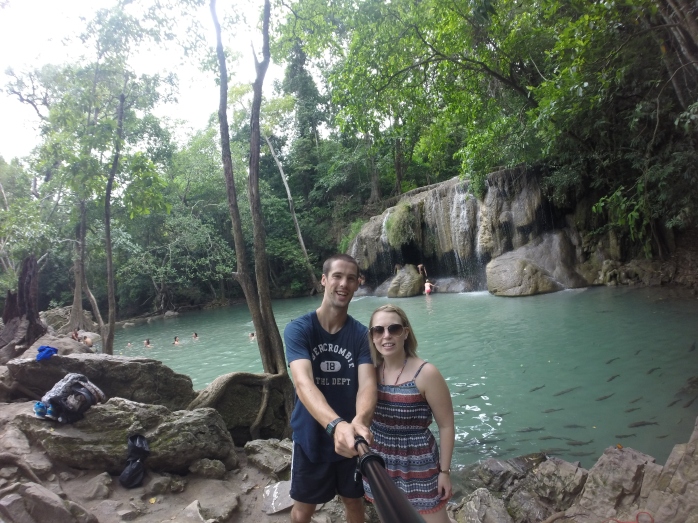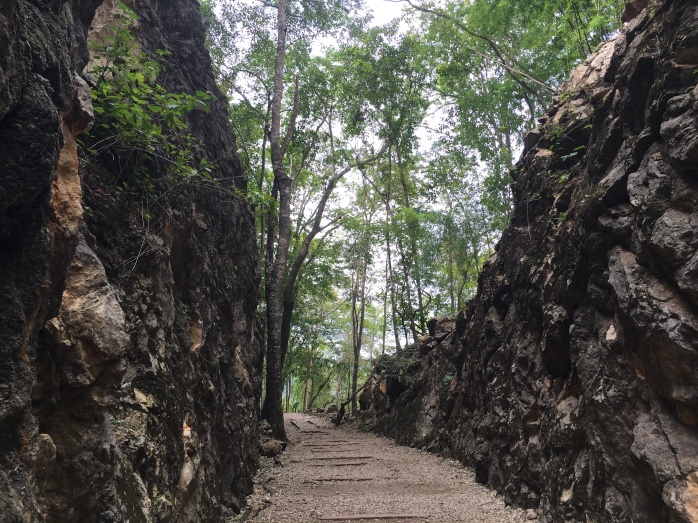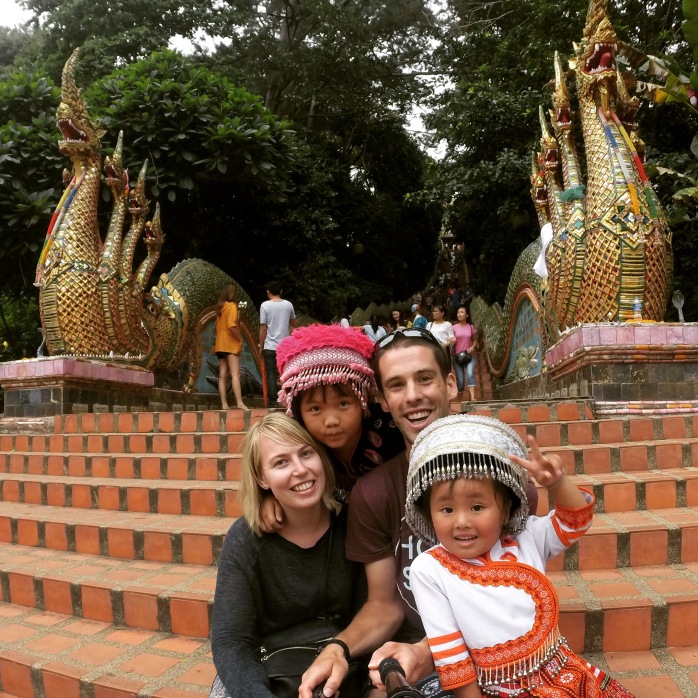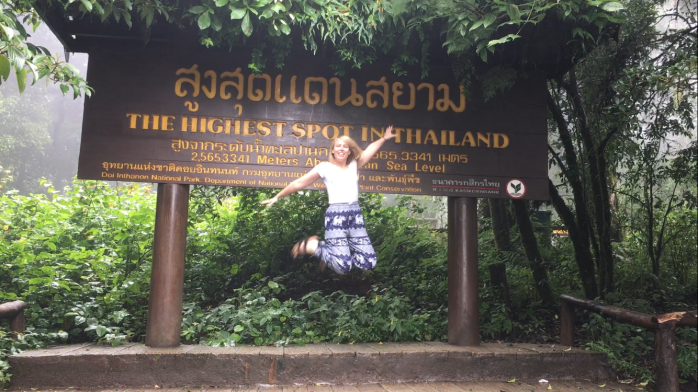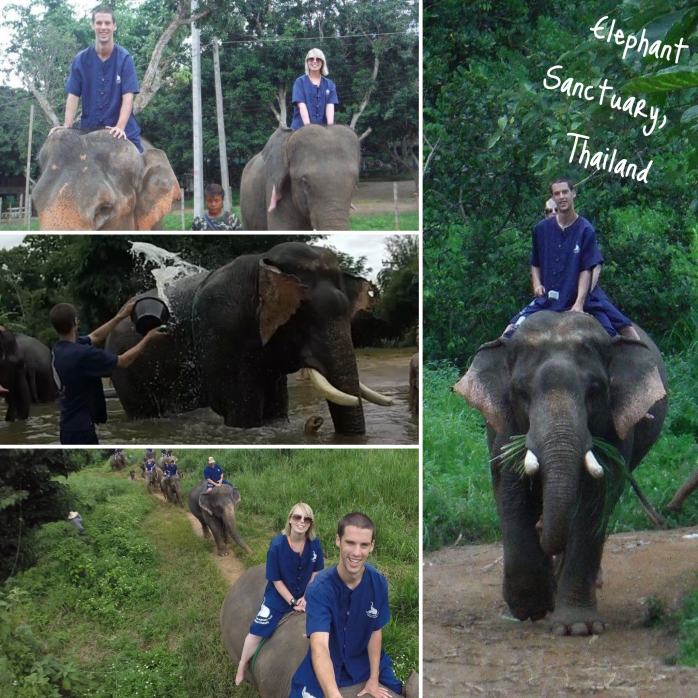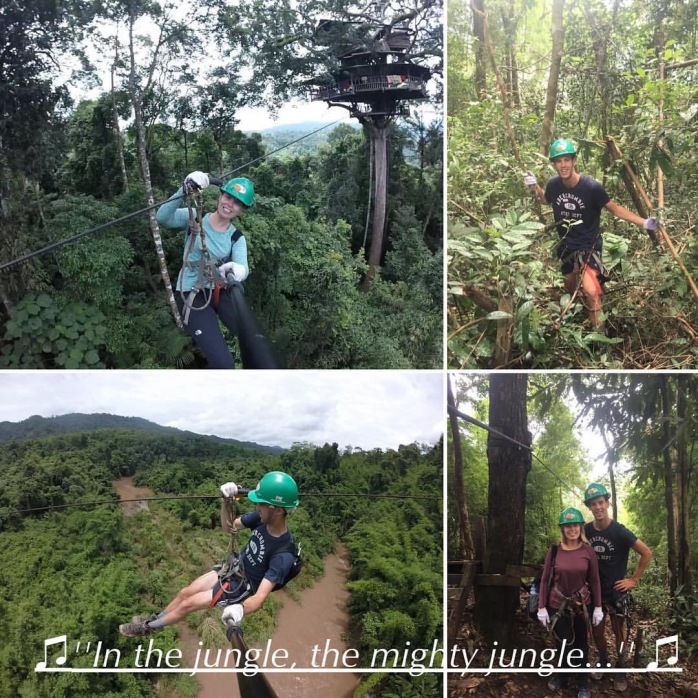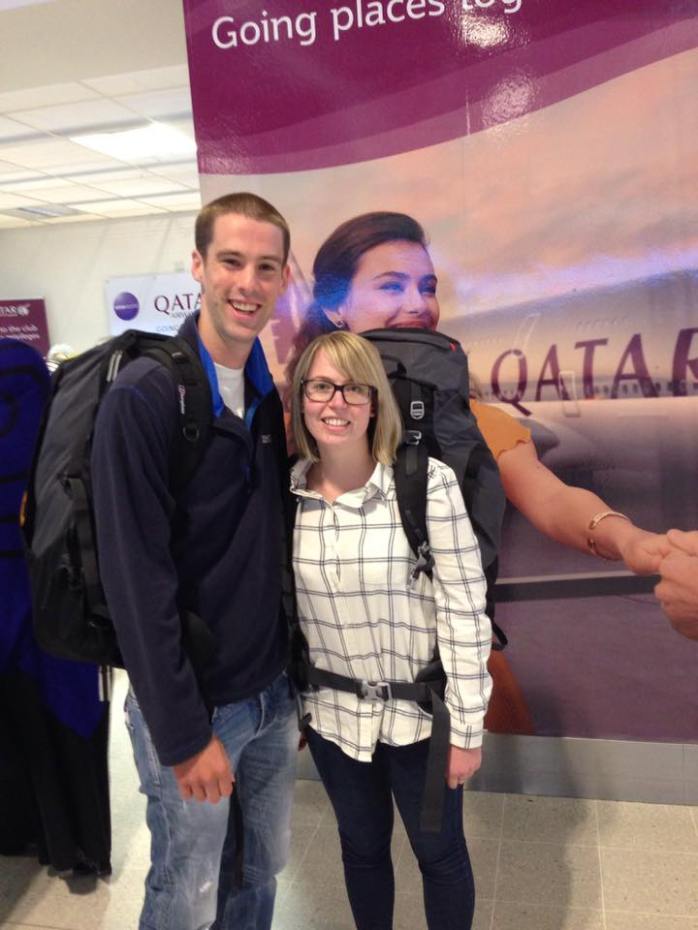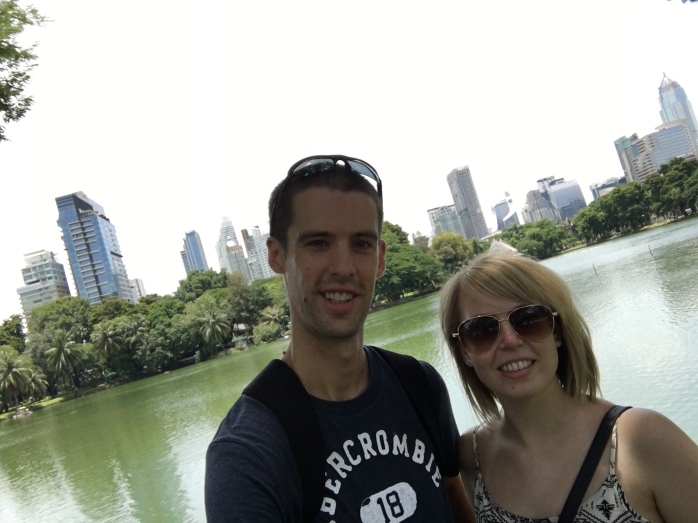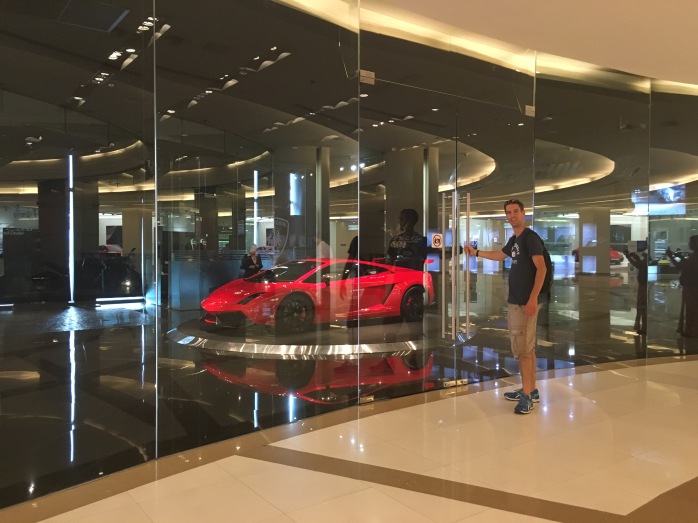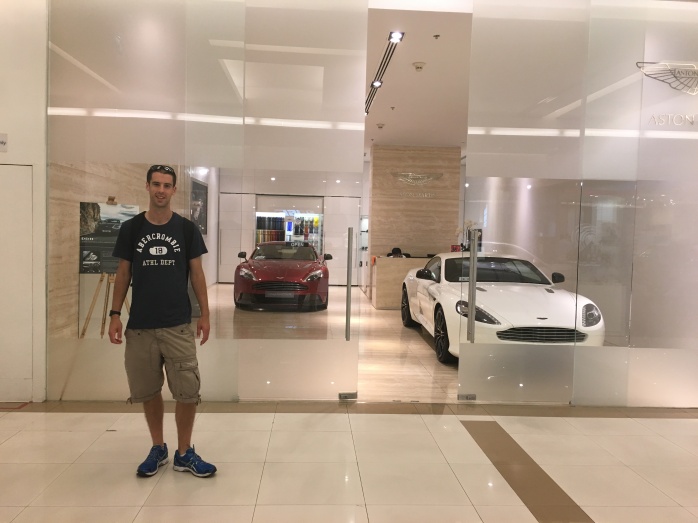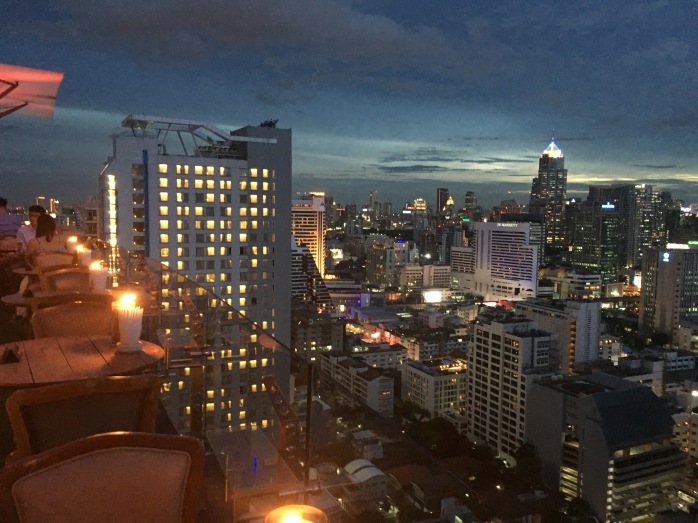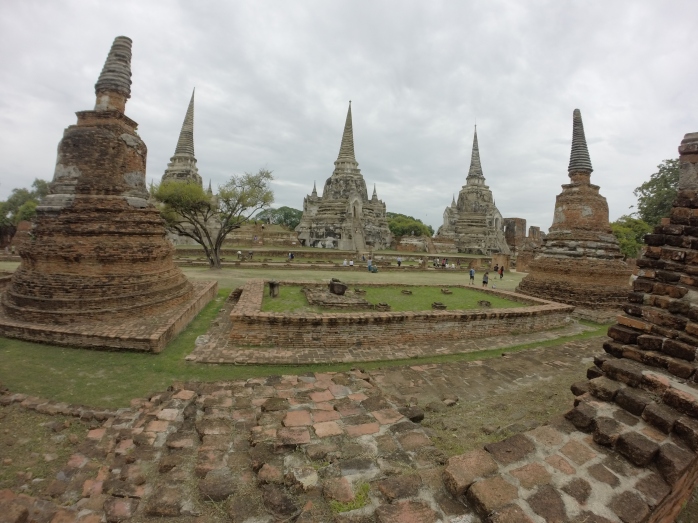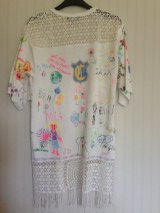Hello!
Happy (Very) Belated Christmas and Happy New Year!

I am so sorry it has taken me so long to post another travel blog. Believe it or not, I actually started typing this post in October! However, we seem to have been moving from one place to another, quicker than I can type! I can’t quite believe that we are now coming to the end of our travels and you will soon be moving into Year 5!
Ste and I have now been travelling for more than 10 months and in that time we have visited 15 different countries; Thailand, Laos, Vietnam, Cambodia, Malaysia, Singapore, Indonesia, Australia, New Zealand, Brazil, Argentina, Chile, Bolivia, Peru and USA. I wonder if you can find the countries and follow our route on a world map?
You may remember, in my last travel blog, Ste and I were about to take a 2-day slow-boat along the Mekong river to Luang-Prabang, a city in Laos. Even though the boat took two full days, it was nice to relax, look at the scenery and experience some of the local life along the Mekong river. The second day was more eventful than the first however, as we had to drive through a thunderstorm. Infact the skipper (the person who drives the boat) had to steer the boat into the bank of the river because he couldn’t see where he was going! Unfortunately, he hit the river bank with such force, that he broke the engine! Luckily, the storm soon passed and two men jumped into the river, wearing only their underpants, to fix the engine! We reached Luang Prabang a little later than anticipated, but the journey was certainly entertaining!


Luang Prabang was a small, quiet, picturesque city. Unfortunately, due to heavy rainfall we were unable to visit some of the well-known waterfalls in the area. However, we enjoyed exploring the city and experiencing some of the local food and markets instead.
My favourite town in Laos was Vang Vieng. Here we went cycling through rice fields, surrounded by limestone cliffs, jumped and swam in lagoons, kayaked along the river and went tubing through a water cave. The latter basically involved sitting in a rubber ring, holding on a rope and pulling ourselves through a cave which was filled with water.



On 27th August, we flew from Laos to Hanoi, the capital city of Vietnam. If I had to choose, I would probably say Vietnam was my favourite country in South-East Asia, mainly due to its different landscapes and culture. However, when we first arrived, it took some time to get used to the traffic! The Vietnamese don’t seem to follow any form of Highway Code (road rules), nor stop for pedestrians who wish to cross the road. You just have to step out and walk across the road, hoping that the traffic moves around you! Mopeds (small motorbikes, sometimes called scooters) are the main form of transport in Vietnam. They weave in and out of the traffic, even if that means driving on the wrong side of the road! A single moped is used like a family car. Often there are at least two adults and two children on one moped! Mopeds line the sides of the streets and often pavements are taken over with parking mopeds, forcing pedestrians to walk on the busy roads.

Hanoi is a busy, vibrant city. One of the most well-known sites is Hoàn Kiếm Lake, which has a small red bridge leading visitors and locals to Ngoc Son temple, in the centre of the lake. At 6am, each morning, many locals participate in tai chi around the lake front.

After spending a day in Hanoi, we took an overnight train to Sapa, where we participated in a 2-day trek. Sapa is a beautiful town, north of Hanoi, famous for its impressive rice terraces. We were joined by seven like-minded travellers and led by a local tour guide named Mai, who was part of the Hmong tribe.


Apparently there are many tribes in the Sapa region and they all have their own traditions and dress. Many people in the Hmong tribe get married between the ages of 16 and 20. Once they are married they wear large earrings, rather than a ring. However, in the red scarf tribe, the women shave the top of their hair and their eyebrows to symbolise their marriage status instead! Mai told us that many married couples, in Sapa, used to have lots of children. However, the rice fields get split between the sons in the family. She explained that married couples are now having less children, so their sons can own more land. The youngest son continues to live with his family once he is married, and the older children find a new house to live in. It was fascinating to hear about their way of life and compare it to our English traditions.
In the evening, we stayed at a local homestay. (A homestay is where you stay with a local family, in their home.) Our homestay host, Sue, and her husband, had four children in total. They also had pet pigs, chickens, roosters and a dog. There was a westernised toilet (instead of a hole in the ground), a hot shower ( a rarity in Vietnam), two large rooms for guests, one small bedroom for all four children, an even smaller bedroom for our homestay hosts, a large kitchen and a small dining/lounge area. There was also an outdoor area, with a table, where we spent the majority of our time chatting with our new travel friends.


For dinner, Sue and her family prepared a delicious Vietnamese meal. This included Vietnamese spring rolls, rice and a variety of meat and vegetable accompaniments; which we ate with chopsticks.
After dinner I spent some time with Sue and her family, helping them learn English. Once a teacher, always a teacher.

Following our 2-day tour in Sapa, we spent another day exploring Hanoi, before departing on a 2-day, 1-night tour to Halong Bay, via a traditional junk boat.
The landscape of Halong Bay is breathtaking. I could have spent the entire trip sunbathing on the sun deck, surrounded by limestone islands.
During our cruise we visited the ‘Surprise cave’ which was like a tardis – small from the outside, but ‘surprisingly’ large inside. We also went sea kayaking, made Vietnamese spring rolls and visited a number of viewpoints, bays and beaches.




Following our 2-day cruise and after arriving back in Hanoi, we took an overnight train to Hoi An. Hoi An is located along the East coast of Vietnam, South of Hanoi. I particularly liked the colourful lanterns, cobbled streets and the close proximity to the beach. Inside the old city, only bikes and pedestrians are permitted, which made it pleasantly peaceful, in comparison to the usual Vietnam traffic.


In the evening, we took a boat ride along the river, where we placed a floating lantern in the water and made a wish. It reminded me of the film ‘Tangled,’ where all the lanterns get lit for Rapunzal’s birthday.

After our time in Hoi An we continued travelling along the East coast of Vietnam, visiting Nha Trang (a popular beach destination), Dalat (which had lots of crazy architecture – see the picture below) and Ho Chi Minh (Vietnam’s most populated city).

Whilst we were in Ho Chi Minh, we went to visit the Cu Chi tunnels. During the Vietnamese war, the Vietnamese fought against the Americans. The Americans had a strong army with powerful weapons, so the Vietnamese had to use clever tactics and traps to defend their country. The Vietnamese also built a network of secret tunnels, known as the Cu Chi tunnels, to keep their families safe. These were well-camouflaged and too small for the Americans to fit inside. Both Ste and I went inside a replica tunnel and we literally had to crawl and slither our way through. It was hard to imagine, hiding down there for a long period of time.

After our time in Ho Chi Minh, we took a bus to Cambodia, where we visited two popular cities; Phnom Penh and Siem Reap. Personally, my favourite was Siem Reap. Siem Reap is well-known for it’s temples and apparently there are over one thousand temples, in Siem Reap alone!
One of the most famous temples is Angkor Wat and we, like many others, decided to visit Angkor Wat at sunrise. (This meant we had to get up at 3.30am!) The sun took one-hour to fully rise and even though there was scaffolding to the left of the temple, it was still a lovely view:

After watching the sunrise, we explored the grounds of the temple, before visiting two other temples; Ta Prohm and Angkor Thom.
Ta Prohm was by far our favourite temple in the Siem Reap area (well, out of the ones we visited). Sections of Ta Prohm were used in the film ‘Tomb Raider.’ We particularly loved the ruined temples and the intertwining trees.


Another highlight of our time in Siem Reap was the Cambodian circus. This involved a traditional tale being told through live music, mime and gymnastics. Both Ste and I were in awe of their gymnastic skills and their muscle strength.


At the end of September, we took a flight from Cambodia to the South West coast of Thailand, where we visited Phuket, Koh Phi Phi (a Thai island) and Krabi. Here we spent most of our time sunbathing, island hopping, snorkelling and trekking to various viewpoints.
Koh Phi Phi, in particular, is how I pictured the Thai coast with its limestone cliffs, long-tail boats and turquoise waters. It certainly was stunning, however I wasn’t anticipating the large amount of tourists, who were beginning to ruin the tranquility of the island.


After our time in South West Thailand, we took a flight from Krabi to Kuala Lumpur. Kuala Lumpur is the capital city of Malaysia and has definitely been influenced by the Western world. After spending two months in Thailand, Laos, Vietnam and Cambodia, it was somewhat of a shock to arrive in a large, clean, wealthy Asian city.
Kuala Lumpur’s iconic landmark is the Petronas Towers:


Even on the pictures above, they look pretty spectacular. They have a curved glass structure, with a glass walking platform adjoining the two towers. You can pay to walk across this platform and view the city skyline, if you wish.
After our time in Kuala Lumpur, we flew to Borneo. Borneo is an island to the right of mainland Malaysia. Half of the island belongs to Malaysia, but the other half is part of Indonesia.
Whilst we were in Borneo, we climbed Malaysia’s highest mountain; Kota Kinabalu. This was by far the hardest trek we have done to date, taking two days to complete.
Many people suffer with altitude sickness during this hike, so we were told to walk slowly, keep hydrated and take regular breaks as we ascended the mountain. We also had to stay overnight, roughly three quarters of the way up the mountain, to acclimatise to the height and conditions.
On the first day we walked for approximately 5-6 hours, until we reached our overnight accommodation. As we ascended the mountain, the air became thinner and we felt ourselves gasping for air. The last few hours were particularly challenging, as the path became very steep and uneven.

As we walked up the mountain, we passed a number of locals who were climbing the mountain with heavy loads on their back. They were either carrying supplies to the mountain lodge we were staying in, or carrying materials to help build another mountain lodge. These individuals would climb the mountain every day so that they could earn a living. For every kg they carried, they were paid a mere 50p! The maximum weight they could carry at a time was 50kg, therefore totalling a maximum income of £10.00 per mountain climb. I soon felt guilty for complaining about the tough trek and once we reached our mountain lodge, we didn’t mind paying for an expensive can of coke after seeing the effort it takes to get there. Sometimes we don’t appreciate how lucky we are.


The following morning we woke at 2am for breakfast, before starting our climb to the summit, equipped with head torches, thermals, hats and gloves. The climb started with never-ending wooden stairs, before pulling ourselves up a steep cliff face with a rope. As we approached the summit, our guide told us to slow down, so that we didn’t reach the summit too quickly. We wanted to arrive at the summit for sunrise, but not too early that we had to wait in the cold, alpine, mountain conditions. Unfortunately, it was too cloudy to see sunrise, but it was still a great feeling to have reached the top.


As we started our descent, the clouds soon dispersed and we were able to see the beautiful valleys and mountains below us. We stopped off at the mountain lodge, on our way down, for a second breakfast, before continuing our descent. I always assume the walk downhill is easier, but the constant pounding on my knees made the last few kilometres difficult. I had to keep telling myself to put one foot in front of the other, despite the pain in my knees. It was such a relief and a great sense of achievement to reach the bottom! We had made it!


The following day we flew to Sepilok, a town on the edge of the Borneo jungle. We could have taken a 6-hour bus journey, but I was glad we had chosen to fly, as I could hardly walk after our mountain climb!
Whilst in Sepilok, we visited the orang-utan rehabilitation centre, the sunbear conservation centre and the rainforest discovery centre; all of which gave us a great insight into the Borneo jungle.
Borneo is one out of two places in the world where you can find wild orang-utans (you can also find them on the island of Sumutra in Indonesia). The orang-utan rehabilitation centre, in Sepilok, was built to look after orphaned or sick orangutans, and to educate others about these beautiful creatures. Each day the orang-utan centre is open to the public, where you can watch the orang-utans being fed twice a day. They cannot guarantee an orangutan sighting, but we were lucky enough to see about twelve orang-utans during our visit. The orang-utans were literally swinging through the trees metres above our head, looking curiously at us with their deep, brown eyes. I hadn’t realised how human-like these creatures actually are. In Malay, the word ‘orang-utan’ literally translates to mean ‘person of the forest.’

Between the two orang-utan feeding times we visited the sunbear conservation centre. Sunbears are the smallest bears in the world. Previously, I had thought koalas were the smallest bear, however koalas are not bears. Koalas are in fact marsupials which means they have a pouch, like a kangaroo. Sunbears are also related to the dog-family and if we listened carefully, we could sometimes hear them panting like a dog! A sunbears diet mainly consists of honey and insects, therefore they have long tongues to reach inside hollow tree trunks and bee hives. They also have long, sharp claws, so that they can climb up tree trunks or dig for food.


During our time in Sepilok we also visited the rainforest discovery centre, where we were able to physically see the different layers of the jungle canopy; emergent layer, canopy layer, understory layer and forest floor:

(Diagram taken from google images)
There were different walking trails which allowed us to walk at different heights through the rainforest. One elevated walkway was 26 metres in height, yet there were still trees above us, above the main canopy layer! Do you learn about the rainforest in year 4?

After our time in Sepilok we went on a 3-day tour to the Kinbatangan river, which is located in the heart of the Borneo jungle.
Whilst we were waiting to be picked up for our Kinabatangan river adventure, I went to use the internet, which was about a 30-minute walk away. I left Ste with my large rucksack, containing all my belongings, where he fell asleep on a bench! However, he was soon awoken by an organuntan, who had escaped from the oragnutan centre and was trying to steal my rucksack! Luckily, Ste was able to grab my rucksack off the orangutan, but he wasn’t very happy, as you can tell from the picture below!

Our Kinbatagan river tour was led by a man called Mr Aji, who was extremely passionate about the jungle and its wildlife.
In the 1970’s, Borneo’s rainforest used to cover 75% of the land, but today only 40% is rainforest. The main reason for deforestation, in Borneo, is to plant palm trees, so that they can produce palm oil. Palm oil is used to make unhealthy, processed foods, such as crisps and chocolate. The more people who eat these foods, the more palm oil is needed.
Unfortunately, the smaller the rainforest, the less animals are able to survive. Deforestation destroys habitats and reduces the amount of vegetation for the animals to eat.
Mr Aji informed us that the government are trying to restrict the amount of deforestation, but there are people who are illegally burning parts of the rainforest, so that they can plant palm trees.
Furthermore, farmers are using fertilisers and insecticides (chemicals) to generate more palm oil, which are effecting the animals too. When it rains, the chemicals run into the nearby rivers which kill the fish and other river animals. Animals which drink the water, such as elephants, have died or become seriously ill, after drinking contaminated water. This has had a knock-on effect upon the rest of the food chain. For example, there are less fish to eat so the birds are now eating more snakes, reducing the amount of snakes in the rainforest.
Typically, the palm oil is shipped to Western countries and China, where it is used to make processed foods like Pringles and Diary Milk, where people, like you and me, don’t realise how we are effecting the rainforest. Next time you have something to eat, look at the packaging to see whether it contains any palm oil. You’ll be surprised at how many products you can find.
Mr Aji has met Sir David Attenborough twice and it is not hard to see why. He is a very talented man and can smell, hear and see animals from an impressive distance. He actually communicates with the animals and makes their exact sounds.
During our 3-days we visited different parts of the river, where we would spend hours looking for animals. This required a lot of patience and it was important to stay quiet, so we did not disturb the jungle creatures. One of my favourite animals was the Proboscis monkey, which has a long nose that moves when it makes a noise.

I was also hoping to see an orang-utan in the wild and on our last day Mr Aji spotted one chewing on some bamboo. It was a special moment, seeing such a magnificent creature in its natural environment.
After our time in Borneo, we flew to Singapore, an independent country, south of Malaysia, where we stayed with my Mum and Dad’s friends, who treated us like family. After three months of travelling it was nice to see familiar faces and feel at home.
Singapore is a modern and wealthy city. Many of the buildings are newly built or refurbished.
Singapore has lots of strict rules and laws. For example, it is against the law to chew chewing gum and to not flush the toilet after you have used it! Some rules seem unnecessary, but Singapore is both a clean and safe city. Personally, I think this is due to the strict rules and laws that are enforced.
Lots of people from all over the world live in Singapore. I particularly liked how everyone respected and celebrated each other’s differences.
During our time in Singapore we visited many of the main tourist attractions. Here are a few of our favourites:
Marina Bay Sands

Marina Bay Sands is a hotel in Singapore. It has now become one of the iconic landmarks of the city. The boat at the top holds a pool for hotel guests.
Raffles Hotel

A luxury hotel which opened in 1887. It is famous for its beautiful architecture and many celebrities including the Duke and Duchess of Cambridge have stayed there.
Merlion Park

The Merlion is a mythical creature wth a lion’s head and the body of a fish. The Merlion is often used as a mascot of Singapore.
Gardens by the Bay

Gardens by the Bay is a nature park in the city centre. However, as you can tell from the photo above, it wasn’t like any other park. I particularly liked the colourful mushrooms which looked very futuristic.
Within the city, there is also lots of greenery. We visited the Botanical Gardens and spent a day walking in the nature reserve, which had an exotic, rainforest feel.
After our time in Singapore, we flew to Indonesia, where we decided to visit three of the most popular islands; Java, Bali and Lombok.
Whilst we were here, we visited temples, volcanoes, markets and rice fields. We also spent time on the beach and went snorkelling with turtles!















After our time in Indonesia, we spent just over seven weeks in Australia. We hired a camper-van for most of our trip, which contained a bed, table, cooker, fridge and sink. In the day, there was space for four people to sit around a table in the back of the vehicle. At night, the seats folded down to form a bed and the potable table was stored away.



For the first five weeks we travelled along the East coast of Australia, between Sydney and Cairns. We visited the Blue Mountains, Byron Bay, Brisbane, Noosa, Fraser Island, Magnetic Island and Cairns to name a few.
One of my favourite places was Byron Bay. It had a relaxed atmosphere and the people were extremely friendly. One of the ‘must dos’ in Bryon Bay is a coastal walk to a lighthouse, which had stunning views across the beach and ocean. We went sea kayaking with dolphins, and in season (May-October) you can see whales too.


Australia is abundant with wildlife, many of which are deadly and/or poisonous. I was amazed at the amount of warning signs, from kangaroos and koalas, to crocodiles, sharks and snakes. Whilst we were in North East Australia, we were advised to wear stinger suits (thick wetsuits), in the ocean, to avoid getting stung by marine stingers and jellyfish. In some lifeguarded areas there were stinger nets, though I’m not convinced these were completely stinger safe, as the nets had holes in them!


One of my favourite wildlife encounters was our visit to Australia Zoo, where we got to see some Australian wildlife up close. The zoo itself was made famous by the legendary crocodile hunter, Steve Irwin. When I was younger, he used to have his own TV programme called Crocodile Diaries, where he would share his dangerous crocodile encounters and educational research. Unfortunately, he died about 11 years ago, after being stung by a sting ray, but his family continue to run the zoo and keep his legacy alive. Whilst we were at the zoo, we had the opportunity to cuddle a koala and feed the kangaroos and wombats, who were hopping around freely. We also watched a crocodile show, where the staff fed a crocodile by hand!





During our East coast adventure, we participated in two group tours; Fraser Island and the Whitsundays.
Fraser Island is the biggest sand island in the world. The fact that it also has a rainforest growing on it, makes it even more unique. During our time on Fraser Island we drove 4X4 jeeps on the sand and visited a variety of natural wonders and rock formations. We also visited the Maheno shipwreck, which was washed ashore in 1935 following a cyclone.



Our trip to the Whitsunday Islands was more relaxed than our Fraser Island tour. We spend 2 days and 2 nights onboard a yacht with 16 other people, sailing around the Whitsunday Islands. We spent most of our time sunbathing, relaxing and snorkelling in the Great Barrier Reef. We also visited one of the best beaches in the world, Whitehaven Beach, which is known for it’s 99.9% silicon sand.


Shortly after our trip to the Whitsundays, I broke my foot! That certainly wasn’t a planned part of our trip, but it still didn’t stop me from doing most of the things we had planned. I would like to say I broke it doing something adventurous, but unfortunately I simply fell down a step as I was getting off a bench! Whoops!

We continued North to Cairns, stopping at various National Parks and waterfalls along the way. I had expected to visit lots of beaches in Australia, but I was amazed at the amount of forestry and National Parks too. Infact, North of Cairns is one of the oldest rainforests in the world; Daintree Forest.



After our time in Cairns we flew to Adelaide in South Australia. After spending some time in the city we hired another campervan to travel along the famous Great Ocean Road, where we were amazed by the rock formations and landscapes carved by sea erosion.







We arrived in Melbourne on 23rd December, where we spent the Christmas period. On Christmas Eve we went to a popular carol concert, performed by different Australian celebrities. It felt strange sitting outside in the sunshine, with an ice-cream, on Christmas Eve, but it helped us get into the Christmas spirit. On Christmas Day, we went to the beach where we joined lots of other ‘Aussies’ having a BBQ on the beach.



On 28th December we flew from Melbourne to Sydney where we spent New Year with my Mum and Dad. We climbed over the Sydney harbour bridge (check out our outfits below!) and participated in a cycling tour of the city. We also visited Bondi, Manly, and Watson’s Bay where we walked along the cliff paths and spent time on the beach.





On New Year’s Eve, we watched the midnight fireworks over the harbour bridge, which was truly magical.


On 2nd January 2017 we flew to New Zealand, where we visited both the North and South island. We participated in lots of adventurous activities including; skydiving, hiking, ice-trekking, bike riding and horse-riding. We even visited the film set, Hobbiton, which was used in ‘The Lord of the Rings’ trilogy and ‘The Hobbit.’








We are now in Canada and only have 3 weeks left before flying home.
As you can tell, we have experienced and seen so much. I really am amazed at how beautiful our world is.
I miss you all lots, but I trust you are all working hard and enjoying Year 4.
I hope you had a lovely half-term and enjoyed charity week.
I will post a new blog soon about our adventures in South America and USA.
Lots of love,
Miss Armitage 🙂 xx
















































































































